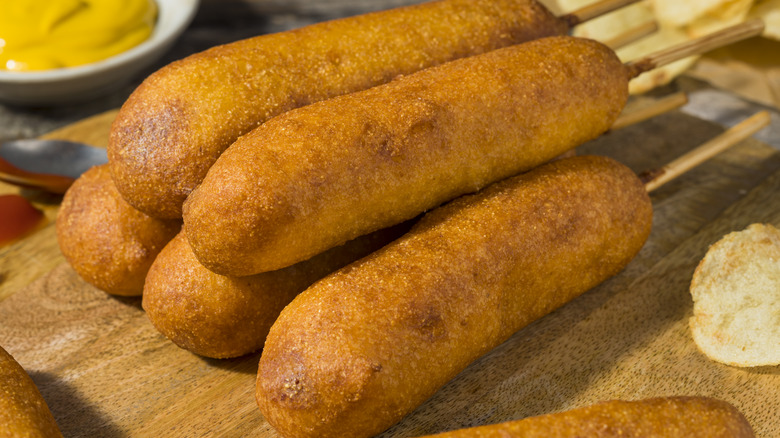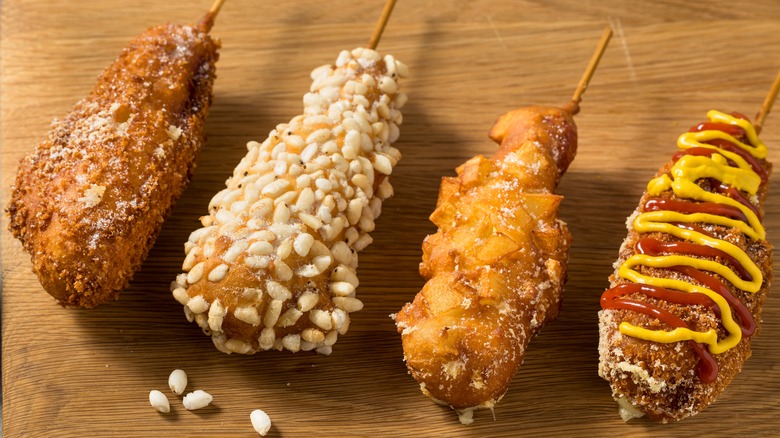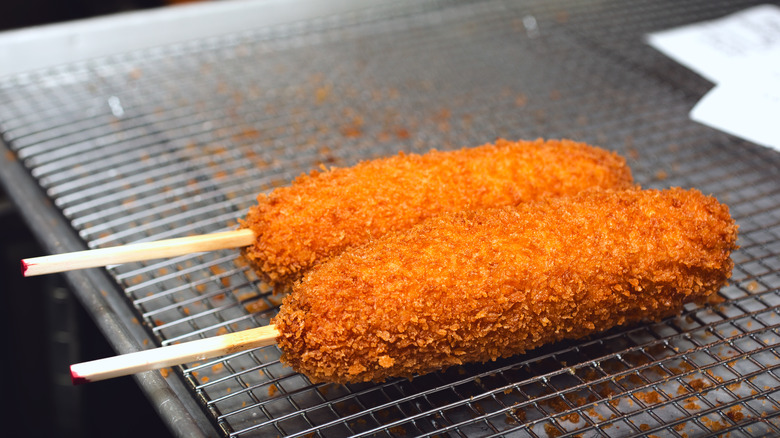The Murky Origins Of The Corn Dog
Corn dogs are popular fare at carnivals and festivals, where the fried sausage or hot dog is commonplace. Yet, trying to figure out where they originated gets tricky. A patent for the food invention was issued in 1929 to Stanley S. Jenkins of Buffalo, New York, considered the inventor of the treat. Though, the first documented appearances of corn dogs didn't come about until the 1940s.
Pronto Pup Co., a go-to concession supplier out of Portland, Oregon, seems to have made the first skewered, deep-fried, and battered hot dogs. Founders George and Vera Boyington got the idea after some buns were ruined during a rainy 1939 Labor Day event. They sold the first "Pronto Pups" from their fountain shop in 1941.
Neil and Carl Fletcher of Fletcher's Original Corny Dogs also got the idea from a local who baked cornmeal-covered hot dogs. But, to save time, the Fletchers upgraded the idea, putting the meat on a stick and dunking it in the deep fryer. They started selling Corny Dogs at the State Fair of Texas in 1942; today, their food trucks are still present at festivals.
Meanwhile, the Cozy Dog Drive-In along Route 66 in Springfield, Illinois claims to have the "original hot dog on a stick" — it happened after co-founder Ed Waldmire tried a baked corn dog sandwich in Muskogee, Oklahoma, and told friend Don Strand about it in fall 1941; Strand's baker father soon helped create a batter, but official Cozy Dogs weren't perfected and launched until 1946.
Corn dog-like foods are enjoyed around the world, too
Though the American version of corn dogs came about in the 1940s, cultures around the world have long made their own versions of the treat. South American countries, such as Argentina and Uruguay, have a corn dog-like street food called "panchuker" — a sausage encased with fried batter and served on a stick. Some versions include cheese and come with sauces.
In Australia, a batter-covered and deep-fried frankfurter on a stick is called by a few names: Dagwood Dog, Pluto Pup, and Dippy Dog. It's typically made fresh at festivals and is served with tomato sauce.
South Korea was first introduced to corn dogs (or kogos) in the 1980s, and creative versions have been emerging ever since. Vendors still use hot dogs but may also sub in fried mozzarella cheese, rice cakes, or fish cakes. Instead of cornmeal, they use rice and wheat flour or yeasted bread dough, and they might add panko, French fries, or ramen to the outer batter. Savory versions are dressed with ketchup, mayonnaise, and/or mustard, while sweet versions feature chocolate, cereal, or powdered sugar.
Additionally, the Japanese make what they call "American dogs" a little differently. Rather than a cornmeal batter, they use pancake mix as a coating, and instead of hot dog meat, they use fish sausage. Though, it doesn't have a fishy or meaty smell or taste like you might expect.
Tips for making and enjoying corn dogs at home
Like the earliest corn dog recipes, today's versions also consist of simple ingredients, and there are a few techniques that make frying them even easier. First, make sure that your sticks are long enough to skewer about halfway up the food while leaving plenty for people to hold onto while eating. Second, the consistency of the cornbread batter can't be so thick that it falls off — thin it out a bit with a touch of milk if that happens.
Third, it's important to keep the oil temperature as steady as possible — 350 degrees Fahrenheit. It will get slightly cooler when you drop a corn dog in, but you don't want it to cool too much. A high-temp penetration probe can help you monitor the oil temp as you go. If you find that making corn dogs is too difficult or time-consuming, though, using cornbread as a hot dog bun is a clever alternative. You could even wrap the dogs in bacon for additional flavor.
While mustard and ketchup are classic corn dog condiments, you can get creative flavors by adding other toppings. Dip the food in burger sauces, honey mustard, queso dip, ranch dressing, or sriracha. To really step outside the box, consider combinations such as chopped pickles and pimento cheese, red pepper flakes and marinara, and hot pepper jelly and cream cheese.



